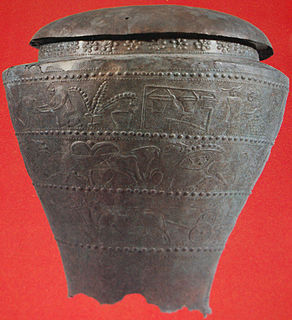 W
WThe Altamura Man is a fossil of the genus Homo discovered in 1993 in a karst sinkhole in the Lamalunga Cave near the city of Altamura, Italy.
 W
WThe Benvenuti Situla is a bronze situla that dates to ca. 600 B.C. It is a product of the situla art that spread north from the Etruscans in this period, in this case to the Este culture that flourished in Este, Veneto during the 7th century BC. The vessel is now conserved in the local National Museum Atestino. The relief work on the vessel depicts scenes of aristocratic life. These include banquetting as well as scenes of military victory. The iconography of the relief scenes of the situla may indicate Etruscan influence.
 W
WThe Deer Cave is a natural cave at the Salento coast near the town of Porto Badisco, around 8 km (5.0 mi) south of Otranto in Apulia, Italy. Unknown before 1970 it came to immediate international attention after the discovery of its impressive, innovative and enigmatic complex galleries of prehistoric parietal wall paintings.
 W
WThe House of the Tragic Poet is a Roman house in Pompeii, Italy dating to the 2nd century BC. The house is famous for its elaborate mosaic floors and frescoes depicting scenes from Greek mythology.
 W
WThe Lovers of Valdaro, also known as the "Valdaro Lovers," are a pair of human skeletons dated as approximately 6,000 years old. They were discovered by archaeologists at a Neolithic tomb in San Giorgio near Mantua, Italy, in 2007. The two humans appear to have died facing each other with arms around each other, thus reminiscent of a "lovers' embrace".
 W
WThe Praeneste fibula is a golden fibula or brooch, today housed in the Museo Preistorico Etnografico Luigi Pigorini in Rome. The fibula bears an inscription in Old Latin, claiming craftsmanship by one Manios and ownership by one Numazios. At the time of its discovery in the late nineteenth century, it was accepted as the earliest known specimen of the Latin language. The authenticity of the inscription has since been disputed. However a new analysis performed in 2011 declared it to be genuine "beyond any reasonable doubt" and to date from the Orientalizing period, in the first half of the seventh century BC.
 W
WThe Romito cave is a natural limestone cave in the Lao Valley of Pollino National Park, near the town of Papasidero in Calabria, Italy. Stratigraphic record of the first excavation confirmed prolonged paleo-human occupation during the Upper Paleolithic since 17,000 years ago and the Neolithic since 6,400 years ago. A single, but exquisite piece of Upper Paleolithic parietal rock engraving was documented. Several burial sites of varying age were initially discovered. Irregularly recurring sessions have led to additional finds, which suggests future excavation work. Notable is the amount of accumulated data that has revealed deeper understanding of prehistoric daily life, the remarkable quality of the rock carvings and the burial named Romito 2, who exhibits features of pathological skeletal conditions (dwarfism).
 W
WThe Sangro Valley Project is an Anglo-American ongoing archaeological excavation in Abruzzo, Italy. It is notable for its revolutionary interpretation of Samnium as a dynamic participant in the history of the Adriatic as well as its early adoption of modern excavation technologies, such as GIS. The project currently managed by Oberlin College in collaboration with Oxford University, Durham University and the Soprintendenza per i Beni Archeologici dell'Abruzzo, is a multi-disciplinary team of specialists from Canada, Italy, the United Kingdom, and the United States.
 W
WThe Uluzzian Culture is a transitional archaeological culture between the Middle paleolithic and the Upper Paleolithic, found in Italy and Greece.
 W
WThe Warrior of Capestrano is a tall limestone statue of a Picene warrior, dated to around the 6th century BC. The statue stands at around 2.09 m. It was discovered accidentally in 1934 by a labourer ploughing the field in the Italian town of Capestrano, along with a female statue in civilian attire, called Lady of Capestrano.